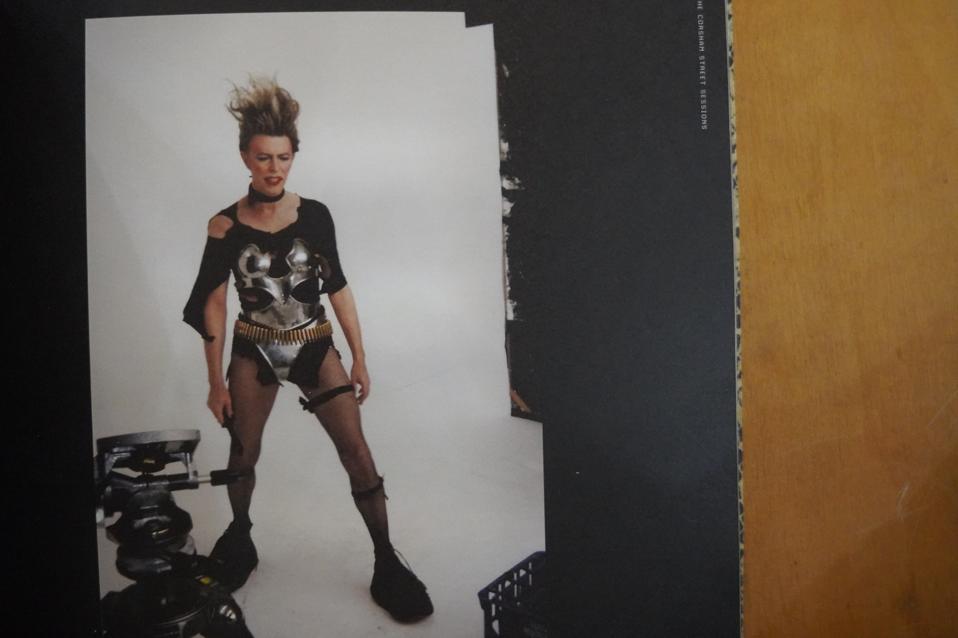On September 25, 1995, David Bowie released his 20th studio album, 1. Outside (The Nathan Adler Diaries: A Hyper Cycle), his first concept album since Diamond Dogs (1974), reuniting him with Brian Eno – his Berlin Trilogy collaborator in the 1970s – for a deeply introspective and non-linear exploration of identity, technology, and art. By gazing back, Bowie, always the innovator, was looking forward, warning us about the world we’re experiencing today.
Multi-disciplinary artist, writer, filmmaker, musician, fashion designer, stylist, and third-generation New Yorker Jennifer Elster transformed Bowie into an array of characters to craft the labyrinthine narrative inspired by Twin Peaks, the wildly influential cult classic mystery-horror drama television series created by Mark Frost and David Lynch, which premiered in 1990. (Bowie, a fan of the show, portrayed Special Agent Phillip Jeffries in Twin Peaks: Fire Walk with Me, a 1992 psychological horror film and prequel to the first two seasons of the TV series, directed by Lynch, and co-written by Lynch and Robert Engels.)
Outside, as it’s known commercially, focuses on residents of the fictional Oxford Town, New Jersey, following Detective Nathan Adler who investigates the murder of a 14-year-old girl. Delving deep into sublime absurdity, Elster transmuted Bowie into a broad range of peculiar characters. The collared shirt Bowie donned as Adler, the slip dress he slinked into as Baby Grace, a blazer he put on to become shop owner Algeria Touchshriek, and a custom garment that was cut on Bowie by Elster and paired with a bullet belt and tights for the character Ramona A. Stone (a throwback to Diamond Dogs) are on view for Elster’s solo exhibition, The Classics at The Development Gallery in New York’s Tribeca, through June 20. The show, which invites viewers to navigate the complex curated space as a unique immersive experience, was extended from its original run (April 17-May 21), setting a mood that resonates amid ongoing geopolitical and social turbulence.
Elster plays with perspective and consciousness in her interactive display, placing some items on the ground and using a rope to keep viewers at a distance from some artifacts and artworks. She opens a verisimilitude of dialogues, borrowing from personal experiences to investigate individual and collective reactions to global turmoil through raw, text-scrawled paintings, jarring historical assemblages, and eerie photographs.
“I’ve been creating since I was a kid, and I don’t think I ever had a specific idea about what I wanted to do. I started that at a very early age, and I think that it was also a way to get through, right?,” Elster said during a walk-through of the gallery last week. “I think when people create art, it’s usually coming from a pure place. It’s just another way to function. So when I was a kid, I did all different types of things, and then I continue to do all different kinds of things, and so some of those things are in here.”
Elster’s singular outlook and dystopian sensibilities are connected to her early career styling counter-culture heroes, such as Bowie, Trent Reznor, Chloe Sevigny, Redman and Method Man from Wu-Tang, and Thurston Moore from Sonic Youth. The objects on view are visceral, drawing us into three decades of Elster’s creative practices. She compels us to reconsider our role in recent history, how we relate to and grapple with the aftermath of shared occurrences, such as the COVID-19 pandemic and the Sept. 11, 2001, attacks, which fundamentally changed our everyday behaviors and relationships with other people. New Yorkers, who are accustomed to sharing small spaces and engaging in frequent interactions, were especially rattled.
“When the plane went into the tower, (my husband and I) were standing outside on our terrace, which had views of the two towers. … The plane was just kind of coming straight at us. Because of the close proximity, it was a very intense experience. … We literally had parts of the World Trade Center falling on us,” Elster said, explaining the contents of a vitrine.
Elster wants viewers to get into her head, literally, with a presentation of enlarged photographs of her mouth and models of her teeth after deciding recently to have braces, which is typical for children between the ages of 9 and 14.
“I just found the process of the braces and everything that had gone on with correcting the bite and everything else is really interesting,” she said, explaining how she repurposed dental diagnostic materials into art.
No doubt Bowie would have laughed and related to Elster’s orthodontic journey, as he had extensive dental work, including tooth replacement with crowns in the early 1990s, to straighten his crooked teeth.

